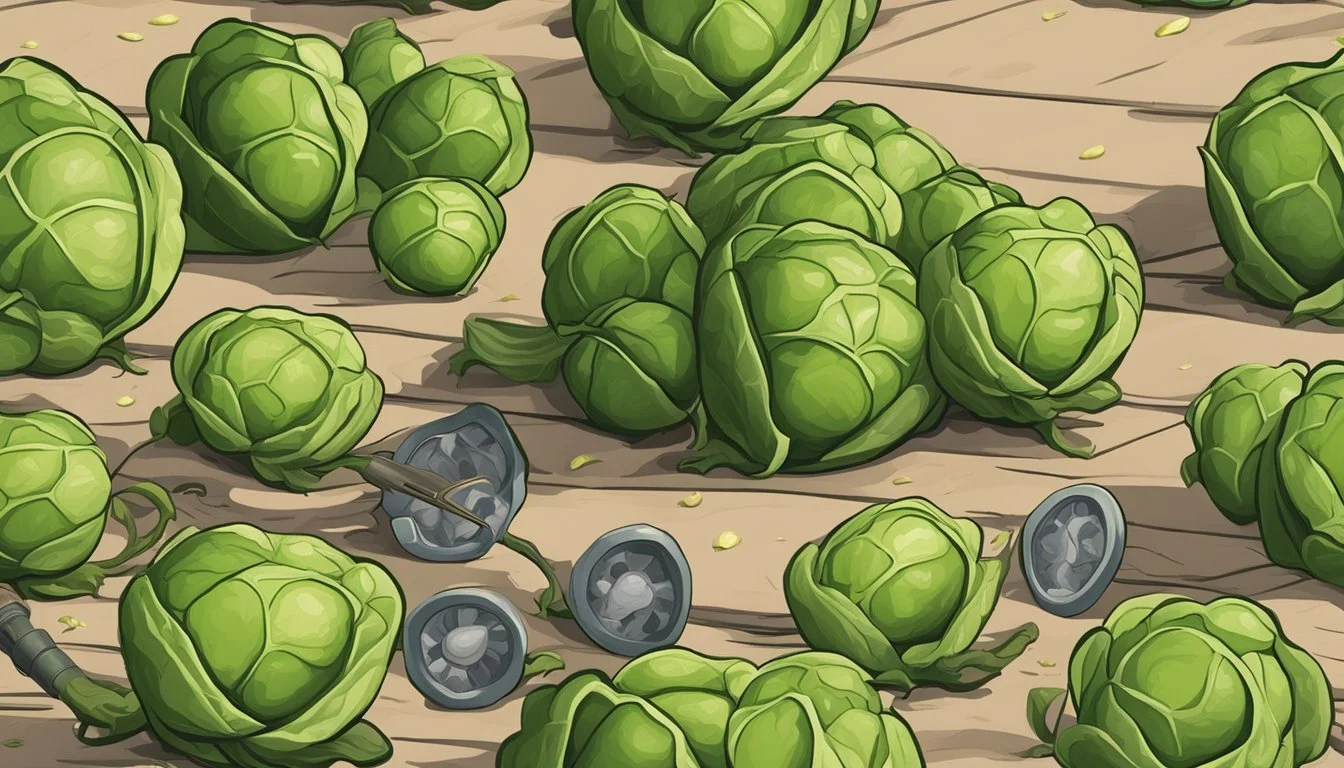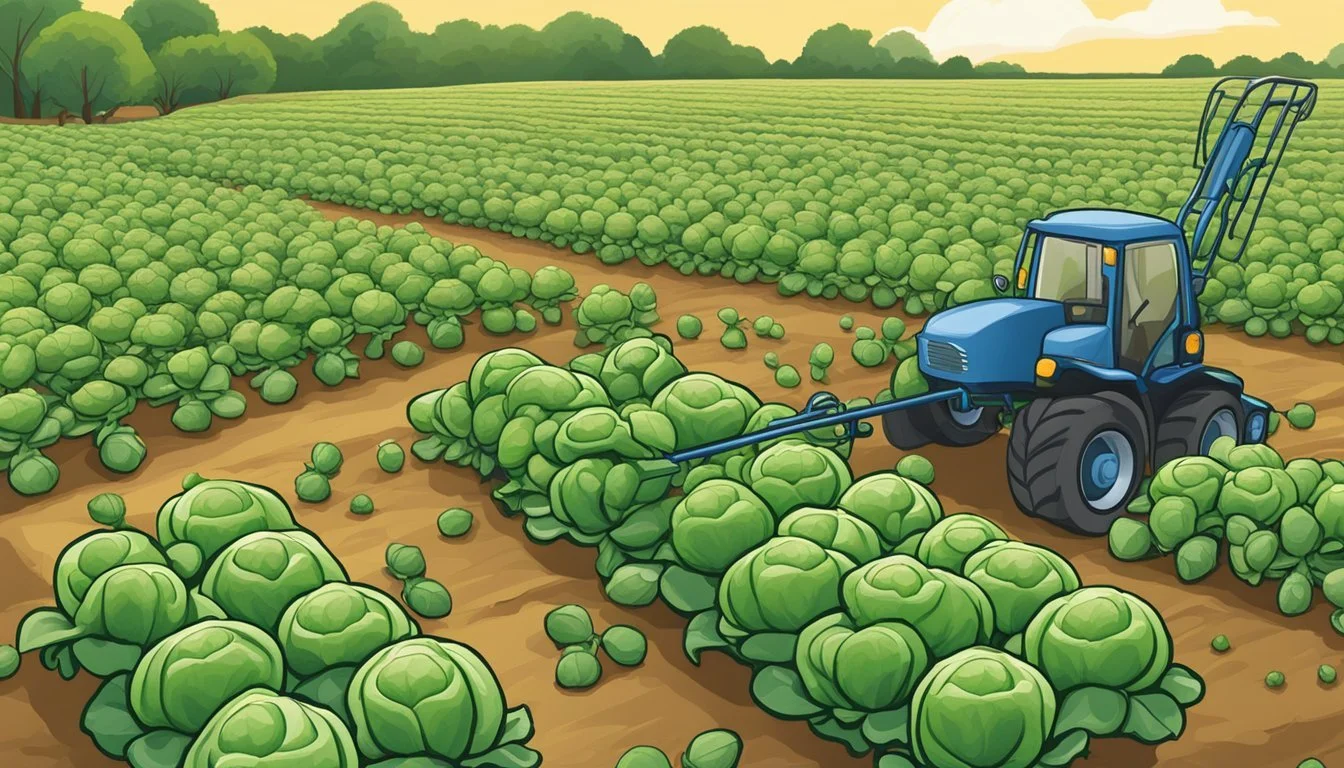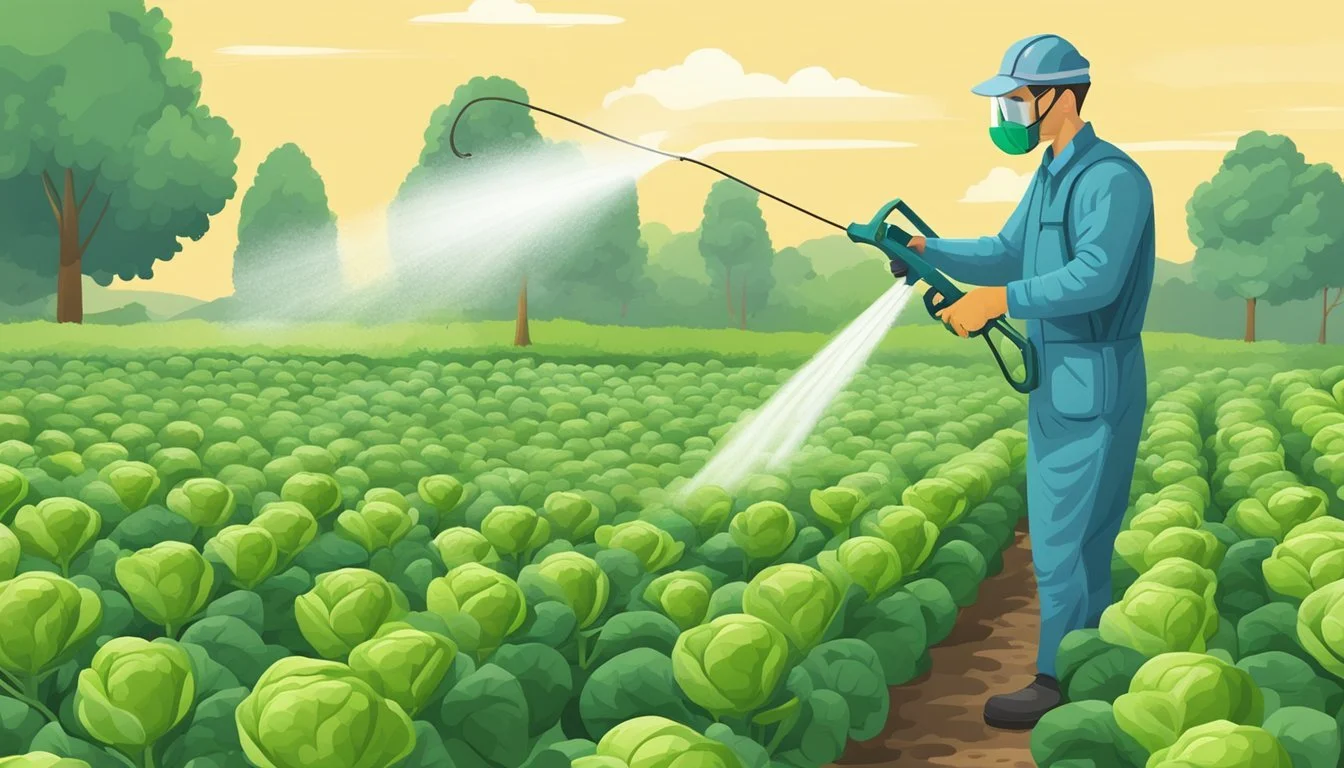Pest Control for Brussels Sprouts
Effective Strategies for Healthy Growth
Brussels sprouts (how long do brussels sprouts last?), a nutritious and hearty vegetable, are popular in home gardens and commercial agriculture alike. However, they are susceptible to a variety of pests that can compromise their health and yield. Understanding the common threats to these vegetables is crucial in maintaining a thriving crop. Effective pest control starts with identifying the insects causing damage, as different pests require different management strategies.
Common brussels sprout pests include flea beetles, which belong to the Chrysomelidae family, and are known for their ability to jump vigorously. These small insects can cause substantial damage to leaves, making them difficult to control if not identified promptly. Other pests such as aphids, caterpillars, and slugs also target the leaves of brussels sprouts, while some pests like root maggots can attack the plant below the soil. Gardeners and farmers must be vigilant and responsive to the presence of these pests to protect their crops.
Cultural practices, biological controls, and the judicious use of pesticides can all play a role in managing pest populations. Rotating crops, using barriers to physically block pests, and introducing natural predators are all effective strategies for keeping brussels sprout pests at bay. A combined approach tailored to the specific pests present can help ensure that these robust vegetables can be grown successfully and with minimal damage.
Understanding Pests and Brussels Sprouts
Brussels sprouts, a nutritious vegetable, are susceptible to several pests that can significantly impact their growth. This section discusses the variety of pests that affect Brussels sprouts, their life cycles, and the overall impact on the plant’s development.
Identifying Common Pests
Several pests are known to attack Brussels sprouts. Aphids, small sap-sucking insects, often cluster on the undersides of leaves, causing yellowing and distorted growth. Caterpillars, including the cabbage looper, feed on the leaves, creating irregular holes. Snails and slugs damage the plants at night, leaving slime trails and large, irregular-shaped holes in the foliage. Flea beetles chew small, round holes into the leaves, while leaf miners create tunnel-like patterns.
Aphids: Clusters of small, sap-sucking insects causing yellowing.
Caterpillars (Cabbage Loopers): Feed on leaves, causing irregular holes.
Snails/Slugs: Leave large holes and slime trails on the foliage at night.
Flea Beetles: Chew small, round holes in the leaves.
Leaf Miners: Larvae create visible tunnels in leaves.
Lifecycle of Brussels Sprout Pests
The lifecycle of these pests involves several stages. For instance, cabbage loopers lay eggs on the undersides of leaves, which hatch into larvae that voraciously feed on the foliage. These pests typically have multiple generations in a season. The knowledge of the pest lifecycle is pivotal for implementing timely and effective control measures.
Cabbage Loopers:
Egg: Laid on leaf undersides.
Larvae: Feed on foliage, causing notable damage.
Generations: Multiple per growing season.
Impact of Pests on Brussels Sprouts Growth
The demeanor of these pests can significantly affect Brussels sprouts growth. Particularly, heavy infestations can cause stunting, reduce leaf area for photosynthesis, and render the sprouts unmarketable. Diseases may also be vectored by pests like aphids, compounding the stress on the plants.
Growth Impact:
Stunting from heavy infestations.
Reduced photosynthesis due to decreased leaf area.
Disease vectoring leading to additional plant stress.
Each pest's impact must be managed differently, and understanding their behavior is key in protecting Brussels sprouts crops efficiently.
Cultural and Physical Control Strategies
Cultural and physical control strategies for managing pests in Brussels sprouts are essential for a healthy and productive garden. These methods help prevent pest infestations by disrupting their lifecycle and making the environment less hospitable for them, without resorting to chemical pesticides.
Implementing Crop Rotation
Crop rotation is an effective strategy to minimize pest problems. By planting Brussels sprouts in different parts of the garden each season, one can reduce the buildup of pests and diseases that favor this crop. This practice not only interrupts the lifecycle of specialized pests but also aids in maintaining healthy soil.
Using Row Covers and Barriers
The use of row covers provides a physical barrier that protects Brussels sprouts from pests. These covers can prevent insects from reaching the foliage and laying eggs, while still allowing water and sunlight to penetrate. Garden netting can similarly be used to safeguard the plants, especially during the vulnerable seedling stage.
Practicing Companion Planting
Companion planting is the technique of growing certain plants alongside Brussels sprouts to naturally repel pests or attract beneficial insects. For example, planting marigolds can deter nematodes, while herbs like dill might attract predatory insects that feed on common pests.
Maintaining Garden Hygiene
Keeping the garden clean is crucial to prevent pest infestations. This includes removing weeds which can harbor pests, disposing of infected plant material, and avoiding excess moisture on leaves that can encourage disease. Regular garden maintenance helps create an environment that is more favorable for the Brussels sprouts and less attractive for pests.
Biological Control Methods
Biological control methods offer natural alternatives to chemical pesticides by harnessing the pest-regulation capabilities of living organisms. These strategies can create a balanced ecosystem that controls pest populations and supports the health of Brussels sprouts plants.
Encouraging Beneficial Insects
Ladybugs and lacewings are beneficial insects that eat common pests like aphids and mites, which frequently attack Brussels sprouts. By planting flower varieties adjacent to your Brussels sprouts that attract these insects, such as alyssum and fennel, gardeners can increase the population of these natural predators to manage pest infestations effectively.
Understanding Soil Nematodes
Nematodes, specifically entomopathogenic nematodes, can be introduced to Brussels sprouts gardens to combat soil-dwelling pests. These microscopic worms infest harmful insects, including those within the Brassicaceae family crops, minimizing damage without resorting to harmful chemicals.
Deploying Birds and Predators
Birds can be excellent allies in pest control, as they feed on a wide variety of insects. To harness their appetites, gardeners may install bird feeders or birdhouses to invite them into the garden space. Furthermore, other natural predators such as toads and garden snakes also contribute to controlling pests that threaten Brussels sprouts, effectively reducing the need for pesticides through biological means.
Chemical and Organic Pesticides
When combating pests on Brussels sprouts, gardeners have a toolbox of chemical and organic pesticides. Each type comes with specific uses and considerations for effective and responsible pest management.
Using Insecticidal Soaps and Oils
Insecticidal soaps are potent against soft-bodied insects like aphids and mites, with minimal impact on beneficial insects when used correctly. For example, an application of insecticidal soap can be used to control these pests on contact. Meanwhile, neem oil serves a dual purpose as both a pesticide and a fungicide, offering a broad spectrum of protection with fewer adverse environmental effects.
Insecticidal Soap: Effective on aphids, mites.
Neem Oil: Acts against various pests; doubles as fungicide.
Applying Bacterial Insecticides
Bacterial insecticides, such as those containing Bacillus thuringiensis (Bt), target specific groups of insects, such as caterpillars, without harming non-target species. These insecticides are ingested by the pest and are particularly useful against worms and caterpillars that may infest Brussels sprouts.
Bacillus thuringiensis: Targets worms, caterpillars.
Choosing Organic Pesticides Wisely
Gardeners seeking organic methods for pest control can consider substances like spinosad and pyrethrin. Spinosad is derived from naturally occurring soil-dwelling bacteria and is effective against a wide range of pests. Pyrethrin, extracted from chrysanthemum flowers, is another organic insecticide that quickly knocks down pests on contact. Organic pesticides, while generally safer for the ecosystem, should still be used judiciously to minimize their impact on beneficial insects and the environment as a whole.
Spinosad: Broad spectrum; originated from soil bacteria.
Pyrethrin: Derived from chrysanthemums; fast-acting.
Preventing Fungal and Bacterial Diseases
Preventing fungal and bacterial diseases in Brussels sprouts is essential for a healthy harvest. Understanding specific strategies like moisture control, resistant varieties, and soil management can significantly reduce the incidence of infections such as powdery mildew, black rot, and clubroot.
Controlling Moisture and Mold
To mitigate the risks of fungal diseases such as downy mildew and white mold, gardeners must carefully manage plant moisture levels. Ensuring proper spacing between plants promotes air circulation, reducing excess moisture and humidity that can foster mold growth. Utilizing drip irrigation or soaker hoses minimizes water contact with foliage, thus decreasing the likelihood of powdery mildew, caused by Erysiphe cruciferarum.
Selecting Disease-Resistant Varieties
Opting for resistant varieties of Brussels sprouts can be a game-changer in combating diseases like ring spot and alternaria leaf spot. Not all Brussels sprouts show the same susceptibility to fungal pathogens; therefore, selecting cultivars that have shown resistance to Xanthomonas campestris or Plasmodiophora brassicae, the pathogens responsible for black rot and clubroot, respectively, is a proactive defense measure.
Addressing Nutrient Deficiency and Soil pH
Healthy soil rich in nutrients is a key factor in preventing Brussels sprouts diseases. A balanced supply of nutrients helps plants better withstand diseases like white rust and alternaria leaf spot. Periodic soil tests can guide the appropriate addition of lime to adjust soil pH, which can also suppress clubroot. Maintaining a soil pH between 6.5 and 7.0 makes an inhospitable environment for many pathogens that cause fungal diseases.
Special Considerations for Growing Brussels Sprouts
Growing Brussels sprouts successfully requires attention to planting schedules, ongoing care to respond to stress, and appropriate techniques for harvesting and storage.
Choosing the Right Time and Spacing for Planting
Brussels sprouts thrive in cooler temperatures and do best when planted in a timeframe that allows them to mature in the fall. Planting should occur so that sprouts have ample time to develop before the first frost. Seeds or seedlings should be spaced 18 to 24 inches apart in rows spaced 24 to 30 inches apart. This spacing helps to ensure that each sprout receives enough sunlight and air circulation to grow into a healthy, green, full-sized plant without becoming stunted due to overcrowding.
Monitoring for Signs of Stress and Defoliation
As they grow, Brussels sprouts require vigilance to maintain their health and productivity. Symptoms of stress may include leaves yellowing or plants exhibiting stunted growth. Defoliation, caused by pests or diseases, can severely impact the development of the tiny cabbage-like heads. Regular inspection of plants is crucial to identify issues early and apply the appropriate treatments to protect the crop.
Harvesting and Storing Brussels Sprouts
Harvesting begins when the heads are firm and green, typically measuring around 1 to 2 inches in diameter. For the best flavor, wait to harvest until after a light frost. Cut the sprout from the stalk with a sharp knife to avoid damaging the plant. Brussels sprouts can be stored in a cold, humid environment for several weeks, which allows flexibility in timing the harvest to get the best yield from each plant. It's important to remember that the outer leaves are removed during cleaning and that heads should be firm to the touch prior to storage.
Integrated Pest Management (IPM)
Integrated Pest Management for Brussels sprouts involves a sustainable approach that uses a combination of practices for effective pest control. These practices are environmentally sensitive and aim to reduce the reliance on chemical pesticides.
Developing an IPM Plan
A comprehensive IPM plan for Brussels sprouts starts with understanding the pest life cycle and their interaction with the environment. The plan should include monitoring and identifying pests, assessing damage levels, and setting action thresholds. Below are specific steps to develop an effective IPM plan:
Soil Health: Begin with enhancing soil fertility to promote strong plant growth, which can naturally resist pests such as fusarium wilt and hyaloperonospora parasitica.
Pest Identification: Regularly inspect crops for pests like flea beetles, cutworms, and cabbage maggots. Use tools such as sticky traps or pheromone lures for accurate identification.
Action Thresholds: Establish levels of pest populations at which control methods must be implemented to prevent reduced yield.
Combining Multiple Control Methods
Effective pest management in Brussels sprouts requires the integration of multiple control methods:
Cultural Controls: Implement crop rotation to break pest cycles and use reflective mulch to deter aphids and thrips. Healthy soil practices suppress root diseases and support beneficial microorganisms.
Mechanical and Physical Controls: Handpicking pests like the diamondback moths and using barriers can significantly lower pest numbers. Additionally, floating row covers can protect young plants from pests such as earwigs and maggots.
Biological Controls: Encourage natural pest predators and consider introducing beneficial insects to control pests such as leaf spot and cabbage maggots.
Chemical Controls: When necessary, apply pesticides as part of an IPM approach, ensuring they target specific pests to minimize harm to non-target species and the environment. Use chemicals as a last resort and follow all label instructions carefully.
By diligently applying the principles of Integrated Pest Management, growers can maintain healthy Brussels sprouts crops and manage pests in an environmentally responsible manner.
Environmental and Safety Considerations
When addressing pest control in Brussels sprouts, gardeners must weigh the environmental repercussions and adhere to safety protocols to protect both the ecosystem and human health.
Understanding the Impact on Ecosystem
Brussels sprouts face numerous pests, yet management tactics can have unintended consequences for the surrounding environment. Beneficial insects, for instance, may fall victim to broad-spectrum pesticides, disrupting the natural balance. It is crucial to identify pests accurately, like the Flea Beetles, which chew through leaves, causing significant damage. Gardeners should opt for targeted controls aimed at the specific pests involved to mitigate collateral damage to non-target species.
Ensuring Safety in Pest Control Practices
Safety in pest control cannot be overstated. Gardeners should always employ methods that minimize risk to human health and the environment. For instance, applying a vinegar and water solution can handle nematodes without harmful chemicals. Moreover, managing pests like leaf miners and caterpillars using eco-friendly options such as neem oil or insecticidal soap ensures safety while effectively targeting the pests. Protective gear, proper application techniques, and adherence to product labels are fundamental safety practices.
Alternatives to Traditional Pest Control
When dealing with pests in Brussels sprouts, traditional chemical pesticides are not the only option. Gardeners can employ various mechanical and manual techniques, as well as organic solutions, to protect their crops effectively and sustainably.
Using Mechanical and Manual Techniques
Handpicking is an effective manual method where one removes pests such as caterpillars or larvae directly from the Brussels sprouts. They can don gloves and systematically check plants, especially during the early morning or late evening when pests are most active. For slugs and snails, setting up traps using shallow dishes of beer can lure them away from the plants.
To deter larger pests like rabbits that may damage Brussels sprouts seedlings, physical barriers such as chicken wire fencing can be employed. The use of aluminum foil around the base of the plants can also reflect light to confuse and deter insects.
Exploring Organic and Diy Solutions
Incorporating companion plants such as tomatoes or squash can help deter certain pests through natural repellency or by attracting beneficial insects that prey on pests. Planting fragrant herbs like chives around Brussels sprouts can discourage aphids and other pests.
One can concoct organic pesticides by mixing kieselgur into a fine powder that damages the exoskeletons of insects or by creating sprays using household ingredients like vinegar. Homemade pest sprays can include a mixture of water, vinegar, and a small amount of soap, which proves effective against soft-bodied insects. Gardeners are known to make a solution with baking soda, oil, and mild dish detergent as a multipurpose pest deterrent and fungicide.
For bird control, one can install netting over the plants or hang shiny objects such as old CDs to deter them through visual disturbance. Utilizing these alternative pest control methods encourages a more ecological approach to gardening while keeping Brussels sprouts healthy.
Frequently Asked Questions
In this section, commonly asked questions about managing pests in Brussels sprouts are addressed, equipping gardeners with practical knowledge for maintaining healthy crops.
What natural remedies can protect Brussels sprouts from insect pests?
Natural remedies such as neem oil and insecticidal soaps are effective in protecting Brussels sprouts from insect pests by providing a barrier that deters infestations.
How can companion planting be used to safeguard Brussels sprouts from pests?
Companion planting involves growing plants like marigolds or herbs that deter pests, alongside Brussels sprouts. This method helps in creating a symbiotic environment that can naturally discourage pest presence.
Which pests are most commonly known to attack Brussels sprouts?
Brussels sprouts are commonly attacked by pests such as flea beetles, aphids, and caterpillars, which can cause significant damage to the plants if not promptly controlled.
How can I identify and manage diseases affecting my Brussels sprouts?
Diseases in Brussels sprouts can often be identified by visible symptoms like wilting, yellowing, or distorted growth. Management involves practices like crop rotation, proper watering, and removing affected plants to prevent the spread of disease.
Are there any DIY pest control solutions effective against Brussels sprouts pests?
DIY pest control solutions, such as handpicking larvae or making homemade sprays with garlic or hot pepper, can be effective against Brussels sprouts pests when applied carefully and consistently.
Can Brussels sprouts still be eaten if they have worms, and how can these be treated?
Brussels sprouts with worms can still be consumed after removing the worms and thoroughly washing the sprouts. Treatment options include introducing beneficial nematodes or using Bt (Bacillus thuringiensis), a natural soil-dwelling bacterium that targets and kills certain types of caterpillars and worms.







